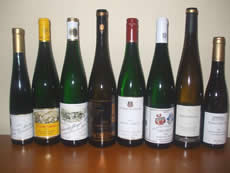 |
| Wines of Mosel-from visited wineries |
I was sitting at the cosy outdoor restaurant in the Richtershof Hotel- a paradise in the small town of Mülheim in the center of middle Mosel valley, with Oliver Haag, son of the Fritz Haag Winery’s owner Wilhelm Haag who has been the paternal figure in the Mosel wine making region. Along with a band of a select few like Ernie Loosen, Egon Müller and Manfred Prüm of J J Prüm wineries, he helped revive the glory of Mosel Rieslings while the famous German river merrily continues to chart its course for millennia.
I was having a quiet dinner at the most popular restaurant in the hotel for casual fine dining within at least 100 km radius, with the young winemaker who joined his illustrious father in 2005, and Marlies Grumbach who distributes Dr. Loosen wines in India through Brindco. Imagine a distributor having a private dinner with another competitor producer in India! Imagine too the coincidence of Ernie Loosen walking in with another journalist from Florida, wanting to join us at our table. Unlike India where re-adjustment of the seating arrangements in restaurants could be in the customer’s domain, this was not easy here due to pre-reserved seating; I was scheduled to have dinner with Ernie the next evening anyway.
Oliver Haag had brought a bottle of unlabelled Riesling which the restaurant was glad to uncork for him (once again, imagine a customer bringing his own bottle in an Indian restaurant-even if it was as rare as the one he was carrying!) It turned out to be an absolutely delicious off-dry (slightly sweet) vivacious Riesling with crisp acidity, dense structure, concentrated yellow fruit with mineral presence but with a noticeable petrol bouquet so typical of an aged Riesling. Oliver asked us to guess the age of the un-labelled bottle. The oldest I could venture was 1995. I was quite off the mark-it was a 1985! A 24 year old white wine which was still refreshing and yet complex!
That is the Mosel Riesling for you- from a quality producer, of course. Fritz Haag is a 5-star producer and definitely one of the Top Five. Although Mosel produces dry Rieslings too, it is also known for slightly sweet, low alcohol (7-8%) well balanced wines that can age and age and age (the sugar helps ageing). While some of them can age for 40 years or even more, even the young ones can be quite drinkable, though some require 3-4 years aging to mellow the acidity levels. They are the absolutely perfect match for the spicy Indian food; both vegetarian-especially the vegetarian, and also a majority of non vegetarian dishes made from fish, chicken and pork.
Mosel can be deceptive too
Unfortunately, as complex as a 1985 Riesling from Fritz Haag is the vine and wine scenario in Mosel where a lot of high yielding super-market type bulk wine is also produced and that is spoiling the name of the region which is also a tourists’ delight because of its steep vineyards along the winding Mosel and quaint little villages replete with churches and forts.
The prime reason for oversupply has been the exploding popularity of the Mosel wines in the UK and US among other countries in the 50s and 60s and there was just not enough Riesling to go around. Although the German Laws were modified in 1971, they paid more attention to the sugar level of grapes at harvest than other viticulture parameters. Vineyards sprang up in the flat lands where potatoes and other crops were being grown earlier. The crops did not yield much in quality but the quantity was under no control either. So many mediocre vineyards and wines entered the scene.
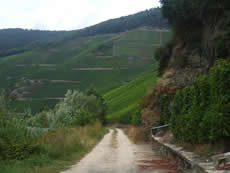 |
| Piesporter vineyards along Mosel |
Nik Weis, the owner of Weingut (German word for wine estate) St. Urbans-Hof has done wonders in a relatively short time of 50 years and owns a small parcel in Piesporter Goldtröpchen vineyards, one of the most well-known and acclaimed vineyards you cannot buy for love or money unless you have some good karma to help you. It is because of these vineyards of grand cru status that Piesport has become a generic name for quality Mosel wine. But as Nik says bitterly, ‘you can own a vineyard 10 kms away from Mosel and still call it a Piesporter (-er as the suffix indicates the village name in Germany). But you may find a Piesporter for € 3 in a supermarket.’
With the competition, it became increasingly difficult for some of these producers to sell so they went back to the original produce. But unfortunately, most of the drop in cultivation has been in the steep vineyards, laments Ernie Loosen. ‘The acreage had gone up from 7000 hAs to 13000 hAs in a decade but is down to 8,000 hAs.’ Pointing to the flat vineyards yonder he says,’ but those vineyards are still in the game.’
Part of the problem also lies in the fact that due to increasing fragmentation cause by the inheritance laws made by Napoleon, many people have estates that are too small to make wine at all and then market it. A co-operative like Moselland Winzergenossenschaft, the biggest in the federal state of Rheinland- Palatinate, with around 3200 growers as members not only takes care of such small growers but is able to give inexpensive and great value-for-money wines, affordable by Indian drinkers burdened with heavy taxes.
Napoleon had introduced the Classification des Vins in 1904 and the Prussian king has got the Mosel region mapped from 1818-32, based on which the Prussian Vineyard Classification was introduced in 1868. Go to any of the top producers and they would show you a copy of this map, pertaining to their vineyard holdings.
Before Napoleon took over, the church used to control the wine industry in Germany. He took it back from the church and had the wineries sold at an auction in Paris in 1806 to private entrepreneurs, thus secularising the industry. But one winery in the center of Trier with the 450 year old vaults right beneath, is still owned by the Bishop’s theological seminary and is known as Bischöfliche Weingüter – actually a merger of 3 different wineries now consolidated. Having one of the biggest holding of vineyards throughout many parts of the region, it makes good quality wines including some Sekt (German sparkling wine).
High Cost of Viticulture
It is extremely difficult and much more expensive to maintain the vineyards in the slopes. Coupled with the fact that they have been badly fragmented from the Napoleon days, it makes it difficult to break even, especially for the small owners. Unless the prices go up, it is not feasible for all of them to survive and one is not surprised to see wild growth encompassing some of the grand cru vineyards, making the task of managing the plants more difficult due to problems created by the wild growth in the neighbouring vineyards.
Restructuring of the vineyards has apparently been going on since the 1950s with the government taking over one whole patch of vineyard area and re-allotting the equivalent plots for replanting, not an easy task because of the varying soil quality throughout a single vineyard. Says Stefan Bergweiler, son of Dr. Pauly Bergweiler, who have their winery in the middle of Bernkastel-Kues, the hub of all tourist activities in the Mittlemosel, and sell half of their domestic sales right at the wine shop opening on the main road, in downtown area, ‘I know that during the next 2-3 years a majority of the vines have to be uprooted for re-planting. We have a lot of area in the Bernkasteler Badstube which is not to be affected. So after a couple of years, we will be one of the very few who would have wines from the old vines.'
Besides vineyard restructuring, the wineries of Mosel are upgrading themselves constantly, looking at the new world styles of wine tourism. I headed straight for my second visit to the Weingut Markus Molitor, one of the rising stars who believes in quality so passionately that he gives 1-3 stars to his wines himself every vintage. Markus Molitor is totally revamping his winery with a Tasting Room which I was told would be the delight of any wine lover visiting the region.
Phylloxera free slopes
Markus is not the only young winemaker passionate to get the best quality out of the Mosel Terroir. Johannes Selbach, who owns Weingut Selbach-Oster in Zeltingen is fortunate enough to have some of the best parcels in the steep slopes of Bernkastel, Graach, Wehlen and Zeltingen-all very prestigious areas. He is shifting more from the off-dry to dry style. Most of these steep slate vineyards were spared the phylloxera and as Barbara Selbach, his wife says, ‘many of our vineyards are still planted with very old ungrafted vines. We have also introduced mechanisation for some of the steep vineyards.’ Thanks to the hard work put in by Johannes’ father Hans Selbach, the winery is reaching its crescendo very fast.
Modernisation of facilities
The renovated winery of Weingut Forstmeister Geltz- Zilliken in the Saar region owned by Hans- Joachim Zilliken is walking distance from the center of Saarburg and sitting in his Tasting Room facing the Saar river and the beautiful greenery all around one does not feel part of a winery but the living room of his residence which adjoins the new addition anyway. It is only when you step out into the area outside his house that you see the overpowering, steep Saarburger Rausch vineyards which have made his quality come up to the top in the last 10 years.
Famous Vineyards of Mosel
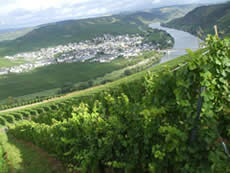 |
| Winding Mosel and Vineyards near Leiwen |
Like the well-known grand-cru class vineyards of Burgundy, fine wines of Mosel are classified by grand cru vineyards known as GG- Grosses Gewächs, or Erstes Gewachs (First Growths) or Erste Lage. Indeed, you go to any top producer and he’d show you a map of the winding Mosel river with coloured contours on either side, depending on the sun location. South, South West or South East are where the best location sites are.
In the 1860s, the ruling Napoleon administration had sought to classify the vineyards with a view to tax wines according to the quality of vineyards. Unlike Burgundy where a similar classification was done and the system of defining the Grand Cru and Premier Cru vineyards still exists, the German laws never did take full cognisance of the terroir. Says Ernie Loosen of Dr. Loosen, ' it’s a pity that in Burgundy they classify according to the nature and in Mosel by sugar.' He explains that while Burgundy defines the vineyards based on their soil and terroir the German system classifies wine on the basis of sugar level at the point of harvest and hence wines like kabinett, späslese, auslese etc.
VDP- Verband Deutscher Prädikats is a century-old Association of discerning producers and the elite membership of about 200 throughout Germany, including Mosel ensures highest standards of wine from its members.
Many of the grand cru vineyards are well known and premium producers own small parcels within the same classified vineyard. The 8 foot-pole that carries the vine displays the ownership through a colour coding at the top. Ernie showed us a small stretch in Ürziger Weingarten where 7 plants are owned by 4 producers including him! He owns another small parcel of it in Wehlener Sonneuhr vineyards which has only 11 vines.
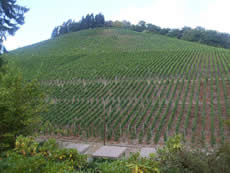 |
| Maximin Grünhauser Herrenberg/Abtsberg Vineyards |
Sonnenuhr, the sundial on the vineyard indicates that the ripening of grapes is the best in those vineyards due to the maximum exposure to sun-naturally these are on the sloping hillside vineyards next to Mosel River. Sonnenuhr vineyards of Wehlen, Zeltingen and Brauneberg Juffer are globally famous. They are top level grand cru vineyards and the labels carry their names. Some of the other prestigious vineyards I was able to visit or shoot are the names you will find on the premium Mosel Rieslings:
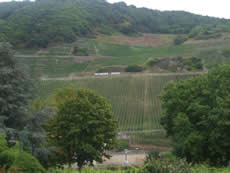 |
| Trittenheimer Apotheke Vineyards |
Erdener Treppchen and Prälat, Bernkastler Doctor, Lay (pronounced as lie) and Badstube, Graacher Himmerlreich and Domprobst, Brauneberger Juffer, Piesporter Goldtröpchen and Domherr, Leiwener Laurentiuslay, Trittenheimer Apotheke. Ürziger Würzgarten, Ockfener Bockstein, Saarburger Rausch, Scharzhofberger, Maximin Grünhauser Herrenberg and Abtsberg, Ayler Kupp, Kaseler Nies’chen. The list is by no means exhaustive and steep vineyards adorn either side of the river, depending on the sun position.
Mosel-Saar-Ruwer is Mosel Now
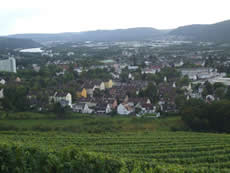 |
| Vineyards at Trier by the Mosel |
The whole of Mosel Valley is divided into five districts called bereichs. Upper Mosel is near Trier while the Lower Mosel is in and around Cochem, known as Bereich Burg Cochem. Mittle Mosel or Bereich Bernkastel is the central part of the valley and is most well-known, not only for the winding Mosel and beautiful gradients, steep vineyards that extend between Ürzigen and Trittenheim but also for the complex, varying characteristics. The two Mosel tributaries of Saar and Ruwer, near the historic city of Trier have the other two districts with their own distinct wines- Bereich Saar and Bereich Ruwer. Till August 2007 the whole region used to be called Mosel-Saar-Ruwer but now according to the law, it is Mosel- to simplify understanding the label.
But the top producers like Egon Müller of Weingut Egon Müller outside Wiltingen in Saar valley and Dr. Carl-Ferdinand von Schubert, owner of Maximin Grünhaus, in the Ruwer valley near Trier are quite cut up. ‘Our soil is so different from the Mosel Valley,’ says Egon, who is the uncrowned king of the Mosel-Saar-Ruwer while Dr. von Schubert minces no words when he says that the decision has been a ‘political decision’ taken to benefit the powerful, bigger volume makers. As a concession, the law now does permit mentioning Saar or Ruwertal separately at the bottom of the label. The decision to change was in fact taken by votes to simplify the labels and Mosel growers being much higher in number were able to prevail.
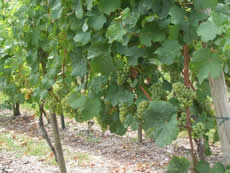 |
| Riesling from Mosel |
There seems to be some criticism of Mosel quality having gone down in the 70s. But after the so-called revival by a band of passionate wine makers including the likes of Wilhelm Haag, Egon Mueller, Ernie Loosen, Von Schubert and Prüm, proper control by the governmental agencies seem to be in place and Mosel is on its way back to the original glory. Quality in general is improving. The top producers concede that there are several small and newer producers who are making very good wines. And the state control is probably far more severe than in any other European country, with controllers coming to the cellars and vineyards at random, say a couple of producers.
If there were aristocracy in India (even in its modern avatar- read affluent, informed, successful and educated wine lovers) who relish fine wine with spicy Indian food, one cannot think of their wine cellars without a sizeable chunk of these Rieslings from Mosel.
Because, after all, a Riesling is a Riesling….unless it is from Mosel. And perhaps it should also be called ‘Moseling’.
Subhash Arora
http://www.bischoeflicheweingueter.de/
www.drloosen.de
www.zelliken-vdp.de
www.vonschubert.com
|